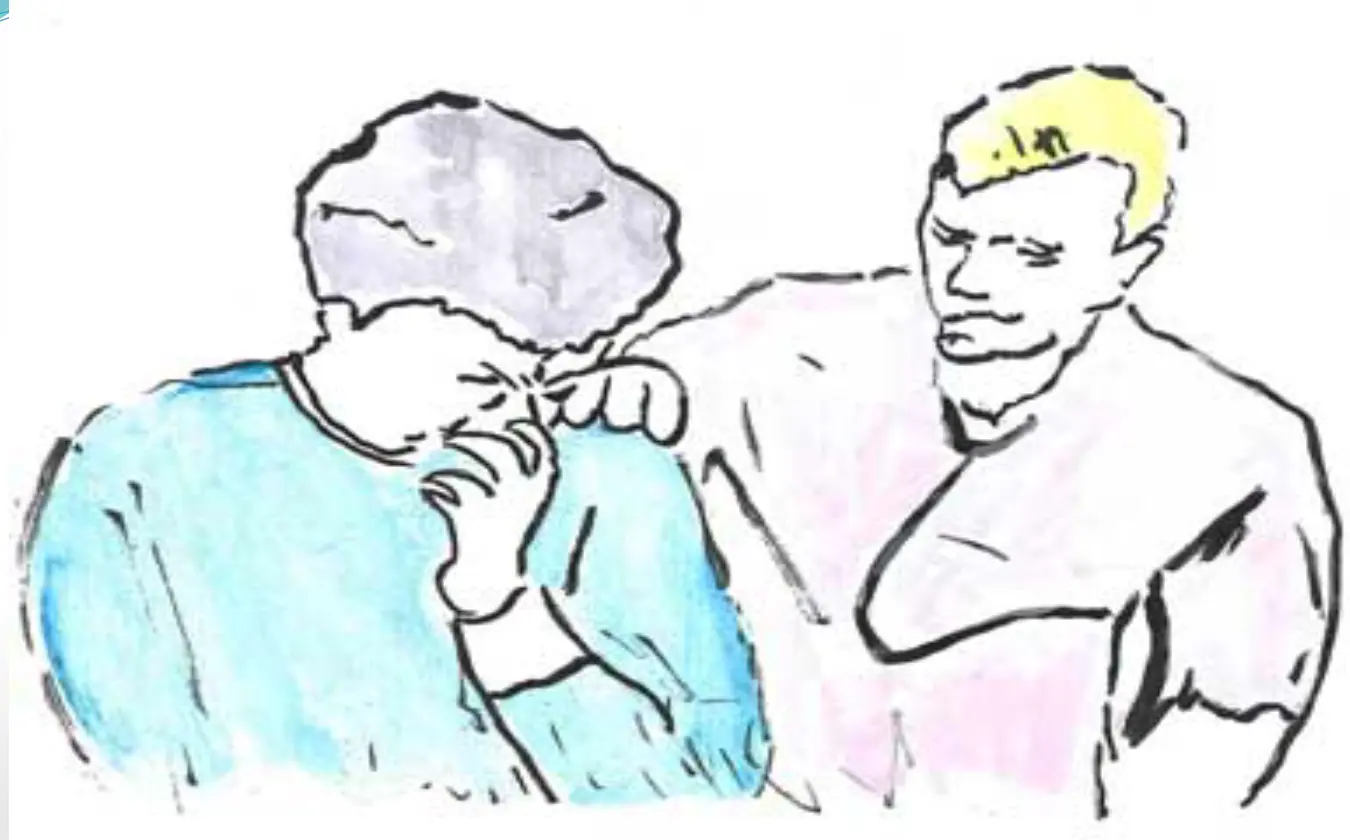Breaking Bad News

Questions for discussion
-
What is bad news?
-
Give examples of bad news?
-
Why breaking bad news is difficult?
-
What are the benefits when effectively breaking bad news?
-
What S.P.I.K.E.S (6 Steps Protocol stand for)?
-
What are the causes of fear in bad news?
-
If a patient with lung cancer asked you “patient like me survive for how long” what is your reply?
-
What not to do in BBNs?
1. What is Bad News?

BBN: a definition
- Bad news is any news that seriously and adversely affects the patient’s view of his or her future.
Buckman 1992

What is bad news?
- Bad news can mean different things to different people
- “any information, which adversely and seriously affects an individual’s view of his or her future”
- A message which conveys to an individual fewer choices in his or her life.
Situations of Concern
-
situations where there is either
- a feeling of no hope,
- a threat to a person’s mental or physical well-being
- a risk of upsetting an established lifestyle
-
The common denominator is that bad news is a message, which has the potential to shatter hopes and dreams leading to very different lifestyles and futures.
Examples
- A patient who is told he / she is HIV positive.
- The man who is told his partner has Alzheimer’s disease.
- The patient who is told the lump has been diagnosed as cancer.
- The couple who are told they cannot have children.
S.P.I.K.E.S (6 Steps Protocol) Z
Breaking Bad News
-
S - SETTING
-
Anticipate the possibility of bad news, and arrange a follow-up visit after significant scans, biopsies etc.
- Avoid telephone
- Private setting, sitting down
- Turn off beeper, no interruptions
- Ensure adequate time
-
S – SETTING (cont)
- Lab reports, X-rays present
- Support person present, if desired
- Review the condition, basic prognosis and treatments before the visit
- HOPEFUL TONE

-
P - Finding out what the patient knows or PERCEIVES
- Before you tell, ask ……
- What do they Know?
- e.g. “what have you been told so far?”
- How much do you understand about your illness? How do you feel?
- What is troubling you the most?
- What do they Know?
- Note denial (if present) or misinformation
- Before you tell, ask ……
-
I - INVITATION by the patient to share the information
- From the patient to give the information. Would you like me to explain ………? Are you the sort of person who wants to know what’s happening?
- Different ways of asking
- e.g. “Are you the sort of person who…”
- Accept their right not to know
- Aim to get clear invitation
- e.g. “Are you the sort of person who…”
-
K - Giving the KNOWLEDGE and medical facts
- Giving information
- Warning shots
- Small chunks
- Check understanding
➢ Emotions
- Observe for and allow emotional reactions
- Kleenex handy, use of touch (NURS)
- Naming the feeling “I know this is upsetting”
- Understanding “It would be for anyone”
- Respecting “You’re asking all the right questions”
- Supporting “I’ll do everything I can to help you through this.”
➢ Summarise & Strategy
- Have a plan
Kaye’s Model
Breaking Bad News
1 - Preparation
- Know all the facts.
- Ensure privacy.
- Find out who the patient wants present.
- Introduce yourself.
2 - What Does the Patient Know?
- Open ended questions.
- Statements may make the best questions.
- “How did it all start?”

3 - Is More Information Wanted?
- Not forced on them.
- “Would you like me to explain a bit more?”

4 - Give a Warning Shot
- Not straight out with it!
- “I’m afraid it looks rather serious”

6 - Explain If Requested
- Step by step.
- Detail will not be remembered but the way you explain it will be.
7 - Listen to Concerns
- “What are your concerns at the moment?”
- Allow time and space for answers.

8 - Encourage Ventilation of Feelings
- Acknowledge the feelings.
- Non-judgmental.
- Vital step for patient satisfaction.
9 - Summarise
- Concerns.
- Plans for treatment.
- Foster hope.
- ? Written information.
10 - Offer Further
- Availability.
- Information.
- Future needs will change.
4- Why is Breaking Bad News Difficult?
What are your thoughts?
- Concern for how the news will affect client
- Client’s fears of social stigma and impact of disability and illness
- Fear of client’s reaction to the news
- Uncertainty in dealing with intense emotional response
- Fear of being blamed
- Fear of how this affects your emotion
- Challenge of delivering the news appropriately and sensitively for this client
- Not wanting to take away hope
BBN: Why is it important?
Relatively common in clinical practice; includes:
- Diagnosis of life limiting illness
- Disease recurrence
- Spread of disease
- Irreversible side effects
- Positive results of genetic tests
- Discussing palliative and end of life care
- Majority of patients want the truth How bad news is discussed can affect important outcomes, including:
-
Comprehension of information
-
Satisfaction with medical care
-
Level of hopefulness
-
Subsequent psychological adjustment
-
Comfort with breaking bad news may be associated with less stress and burnout in physicians
The interviews
- The interviews
Reactions
- Fear
- Anger
- Despair
- Isolation
- Disappointment
- Depression
- Relief ?
- Disbelief/Denial

BBN: Is there a need for training?
Less than 10% report any formal BBN training
- Ability to break bad news rated by:
- ➢ 53% as good to very good
- ➢ 39% as fair
- ➢ 8% as poor
Causes of Fear in People with a Life Threatening Illness
- Fear of separation from a loved one, home, jobs.
- Fear of becoming a burden to others.
- Fear of losing control.
- Fear for dependents.
- Fear of pain.

Causes of Fear in people with a life threatening illness
- Fear of dying
- Fear of not being able to complete their role
- Fear of being dead
- Fear of the fear of others
Parkes 1998
Take home message
- 7 - Areas
Interview Preparation Steps
- Prepare yourself
- Prepare your setting
- Prepare your patient
- Providing information
- Providing support
- Providing a plan
- After the interview
1- Prepare yourself
- Have your facts right first
- Familiarised yourself with the Patient’s background, medical history, test results & possible future management
- Mentally rehearse the interview including likely questions & potential responses
- Relatives can be in attendance, however you should be guided by the wishes of the patient.
2- Prepare your setting
- Meet in a quiet room
- Arrange some privacy & ensure you are not going to be disturbed
- If you have recently examined the patient, allow him to dress before the interview
3- Prepare your patient
- Assess the patient understanding of their condition
- What do they know already?
- What have they been led to expect?
- Never impose information, respect patient wishes
- Build up gradually.
4- Providing information
- Use basic communication skills: use simple language, listen, follow up verbal & non-verbal cues
- Start at the level of comprehension & vocabulary of the patient
- Avoid excessive bluntness; as it is likely to leave the patient isolated & later angry
- Set the tone. “I am afraid, I have some bad news.”
Guidelines for Communication
- Give the information in small chunks
- Avoid using terms e.g. “there is nothing more we can do for you”
- Be truthful, gentle & courteous
- Offer hope
- Emphasize the positive
- Allow questions.
5- Providing support
- Acknowledge & identify emotions; when a patient is silent, use open Q. “How are you feeling now?”
- Do not say “I know how you feel”
- Allow the patient time to express their emotions
- Unless the patient’s emotions are adequately addressed, it is difficult to move on to discuss other issues, remember it is the patient crises, is not your crises; listen.
6- Providing a plan
- Provide a clear plan for the future, with treatment options & management plan discussed
- Identify support systems; involve relatives & friends
- Offer to meet & talk to the family if not present
- Make written materials available
- Summarized.
7- After the interview
- Make a clear record of the interview, the terms used, the options discussed & the future plan.
- Inform other people looking after the patient what you have done.
- May need to have a number of meetings.
- Follow up the patient.
What not to do
- BBNs over the phone
- Avoid the patient
- Leave patient in suspense
- Lie to the patient
- Tell patient if he or she doesn’t want to know
- Interrupt excessively
- Use jargon
What not to do
- Give excessive information as this causes confusion
- Collude
- Be judgmental
- Give a definite time span (as days to Weeks) or (months to Years) etc.
- Pretend treatment is working if it isn’t
- Say “Nothing can be done.”
One of the famous strategies for breaking bad news is the S1PIKES2 Protocol:
- Explain briefly what SPIKES stand for?
- S1 -------------------------------------------------
- P --------------------------------------------------
- I --------------------------------------------------
- K --------------------------------------------------
- E --------------------------------------------------
- S2 -------------------------------------------------
Match the following phrases in their appropriate place of THE S1-P-I-K-E-S2 Protocol of RBN
- “What are your concerns at the moment?”
- Support person present, if desired
- Offer to meet & talk to the family if not present
- It is more serious than infection.
- “What have you been told so far?”
- Accept the patient right not to know
In SPIKES Protocol, which of the following statement is best describe the Perception?
- a) Making sure that the patient will receive the best possible treatment.
- b) “Before you tell, ask.” What is your understanding?
- c) Mental rehearsal is a useful way for preparing for stressful tasks.
- d) Respect patient wishes not to know.
In preparing the setting for effective breaking bad news before you prepare the physical setting and prepare your patient.
- What you need to do first?
- a) Know all the facts.
- b) Ensure privacy.
- c) Find out who the patient wants present.
- d) Call the reception not interrupt you.